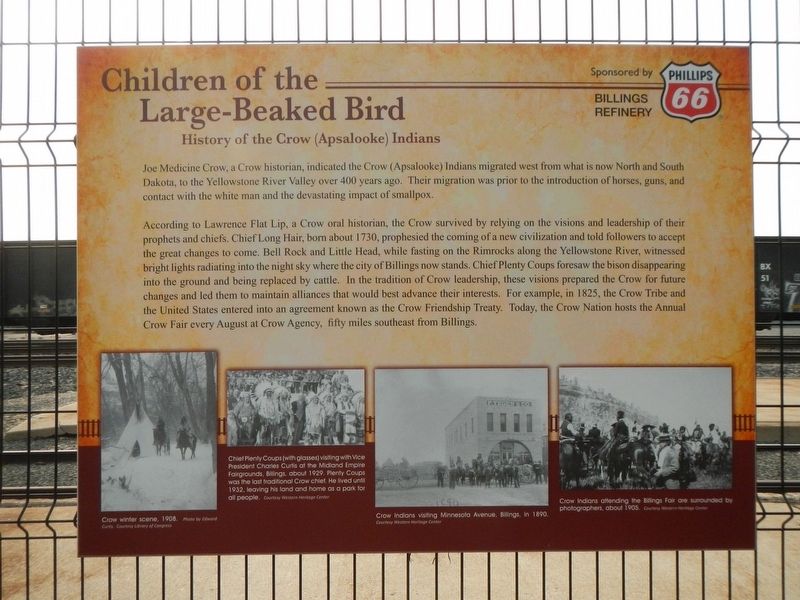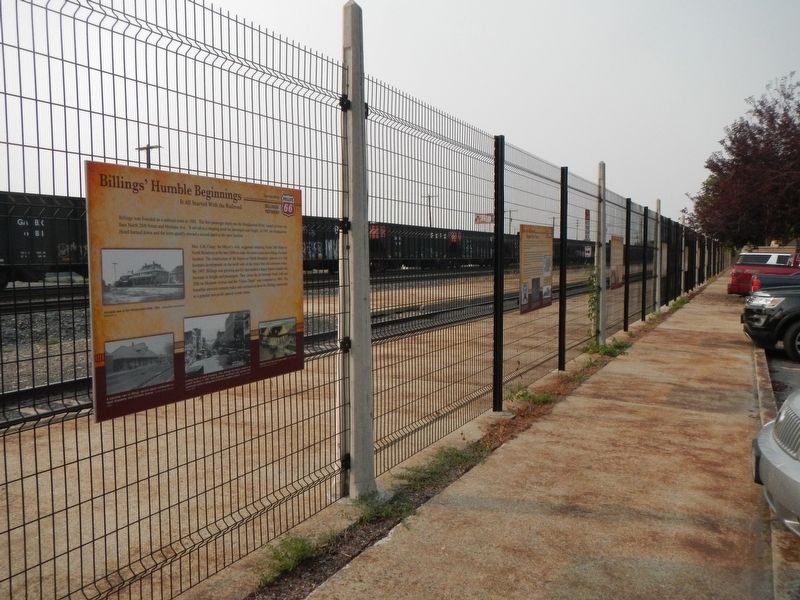North Park in Billings in Yellowstone County, Montana — The American West (Mountains)
Children of the Large-Beaked Bird
History of the Crow (Apsalooke) Indians

Photographed By Barry Swackhamer, September 15, 2020
1. Children of the Large-Beaked Bird Marker
Captions: (bottom left) Crow winter scene, 1908.; (center left) Chief Plenty Coups (with glasses) visiting with Vice President Charles Curtis at the Midland Empire Fairgrounds, Billings, about 1929. Plenty Coups was he last traditional Crow chief. He live until 1932, leaving his land and home as a park for all people.; (center right) Crow Indians visiting Minnesota Avenue, Billings, in 1890.; bottom right) Crow Indians attending the Billings Fair are surrounded by photographers, about 1905.
According to Lawrence Flat Lip, a Crow oral historian, the Crow survived by relying on the visions and leadership of their prophets and chiefs. Chief Long Hair, born about 1730, prophesied the coming of a new civilization and told followers to accept the great changes to come. Bell Rock and Little Head, while fasting on the Rimrocks along the Yellowstone River, witnessed bright lights radiating into the night sky where the city of Billings now stands. Chief Plenty Coups foresaw the bison disappearing into the ground and being replaced by cattle. In the tradition of Crow leadership, these visions prepared the Crow for future changes and led them to maintain alliances that would best advance their interests. For example, in 1825, the Crow tribe and the United States entered into an agreement known as the Crow Friendship Treaty. Today, the Crow Nation hosts the Annual Crow Fair every August at Crow Agency, fifty miles southeast from Billings.
Topics. This historical marker is listed in this topic list: Native Americans .
Location. 45° 47.061′ N, 108° 29.865′ W. Marker is in Billings, Montana, in Yellowstone County. It is in North Park. Marker is on Montana Avenue (Business Interstate 90) near North 23rd Street, on the right when traveling east. The marker is found on a fence paralleling the railroad tracks. Touch for map. Marker is at or near this postal address: 2300 Montana Avenue, Billings MT 59101, United States of America. Touch for directions.
Other nearby markers. At least 8 other markers are within walking distance of this marker. The Fight or Flight of the Nez Perce (a few steps from this marker); Explorer, Guide, and Hunter (a few steps from this marker); Battle of the Little Bighorn (a few steps from this marker); Billings' Chinatown (a few steps from this marker); How the Railroad Shaped Our Town (within shouting distance of this marker); Billings' Humble Beginnings (within shouting distance of this marker); Montana's 70 Million Year Old Beach (within shouting distance of this marker); Northern Cheyenne Tribe (within shouting distance of this marker). Touch for a list and map of all markers in Billings.
Also see . . . Crow people -- Wikipedia. Once established in the Valley of the Yellowstone River and its tributaries on the Northern Plains in Montana and Wyoming, the Crow divided into four groups: the Mountain Crow, River Crow, Kicked in the Bellies, and
Beaver Dries its Fur. Formerly semi-nomad hunters and farmers in the northeastern woodland, they adapted to the nomadic lifestyle of the Plains Indians as hunters and gatherers, and hunted bison. Before 1700, they were using dog travois for carrying goods. (Submitted on March 6, 2021, by Barry Swackhamer of Brentwood, California.)
Credits. This page was last revised on February 16, 2023. It was originally submitted on March 6, 2021, by Barry Swackhamer of Brentwood, California. This page has been viewed 144 times since then and 15 times this year. Photos: 1, 2. submitted on March 6, 2021, by Barry Swackhamer of Brentwood, California.
